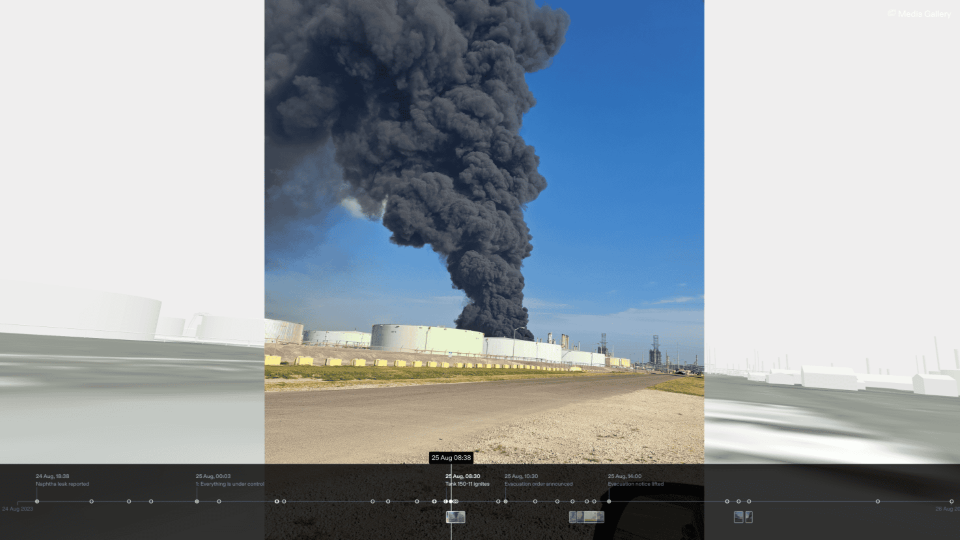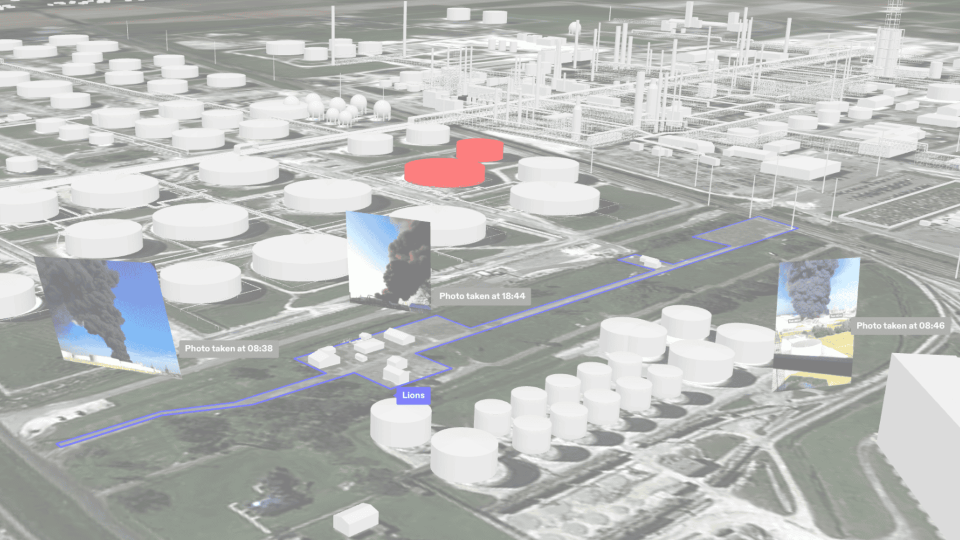Forensic Architecture visual investigation wins prestigious journalism award
Primary page content
An investigation by the Guardian US and Forensic Architecture has won a respected Scripps Howard Journalism Award for Excellence in Environmental Reporting.

An image of the plume from the refinery fire is situated within Forensic Architecture’s digital environment of the facility and surrounding area, accompanied by a timeline of events. Image: Darnell Alboudoor (Forensic Architecture, 2024)
The investigation - ‘The Huge U.S. Toxic Fire Shrouded in Secrecy’ - uncovers the events around a 2023 fire at the US’s third-largest oil refinery, which is operated by Marathon Petroleum in Louisiana.
A storage tank containing at least 26,000 barrels of the flammable hydrocarbon naphtha was on fire. When a resident called the emergency services about the plume of smoke, the Guardian report reveals that the facility had been leaking for more than thirteen hours but “there had been no alert. No blaring sirens. No word from local emergency responders.”
Despite reassurances that there were ‘no offsite impacts’, residents living nearby say the accident caused health issues. The nine-month-long investigation revealed major flaws in local the emergency response.
The heavily polluted region of the US between New Orleans and Baton Rouge, where there are hundreds of chemical plants and refineries, has been dubbed ‘cancer alley’. The investigation reports that residents and experts say the accident is an example of an “embedded culture of secrecy”.
The visual investigation by Goldsmiths-based research agency Forensic Architecture included a 3D simulation of the smoke plume using computational fluid dynamics, created in collaboration with mechanical engineering experts at Imperial College London. The digital model simulated the development and movement of the smoke plume from the fire drawing on data from a local weather station and images from local media and citizens.
The Scripps Howard Journalism Awards recognise high-impact reporting. A judging panel of veteran journalists and media leaders selected the winners from nearly 600 entries offering $140,000 in prize money across twelve award categories.
Bob Trafford, an Assistant Director with Forensic Architecture, said:
“We’re delighted by this award, which is a testament to the diligence, thought, and care that went into months of research by our team, as well as to the persistence of our collaborators, among them victims of environmental racism, who continue to suffer as a result of the actions of Marathon Petroleum and the local authorities.
“It was rewarding to work with the Guardian, who have again demonstrated their enthusiasm for putting new research practices like ours in conversation with traditional journalism."
It’s a great example of how the time and space afforded by our research environment here at Goldsmiths is spurring innovations in mainstream reporting and storytelling, around critical issues of racial and environmental justice.
Bob Trafford, Forensic Architecture
“We hope our research can continue to support the pursuit of accountability and we hope the visibility that this award affords will bring to an even wider audience the possibilities of Forensic Architecture’s model of collaborative investigation.”

Image-data complex drawn from the Forensic Architecture platform, with visual assets sourced from local residents and media geo- and chrono-located within the 3D model of the Marathon factory site.
- Read about the prize-winning investigation on the Scripps Howard Fund website here